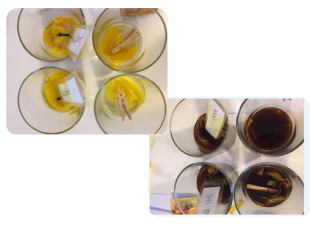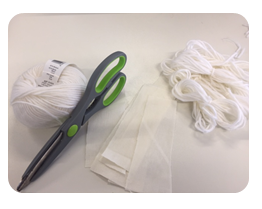4th Assignment l BioFabricating Dyes & Materials
Our 4th week was about exploring material and coloring alternatives to current dying procedures which have heavy impacts on our environment. After the global meeting on Tuesday I started my own experiments of BioFabrication and Dying.
19.10.2017 l FabLab & BioLab Session
I started my preparation by choosing material and cut it properly.
- Animal: 45% Mohair; 45% Wool; 10% Silk
- Vegetable: 100% Linen
In total I had 8 bundles of each material. I prepared name tags where I marked 4 bundles of animal and 4 of vegetable with a “M” for modrant which was important for later processing steps. Hence, the preparation was completed and I could proceed in the BioLab.
.
.
.
We started with cleaning:
1. wash the animal fibres with luke warm water and soap for one hour
2. cook the vegetable fibres with sodium carbonate (Here: baking soda; 2 spoons for 4 litre water) for one hour
Next Step:
4 bundels of each material were predetermined to be treated with a mordant
Mordant = mostly inorganic oxide, used to decrease later impact of light or washing processes on the colour, also influencing the final colour.
- Cook water
- Add mordant depending on the weight of your fabric (we used Acidum Tartaric)
- Add fibers and leave them in the boiling water for 30 minutes
This was the final step in the preparation phase and now we could start with the dying process:
I decided to dye with turmeric: 
Instruction:
Use turmeric powder and mix it to a paste with a little warm water, stir it well to incorporate all the particles. Add more water while stirring before pouring it into the dye bath. This dye solution can be applied to all fibers, with or without heat.
I put ½ weight of fiber (3,75 gram) of Turmeric powder to intense the yellow shades. The recipes says, that pre-mordants are not really needed in the dying process with Turmeric but I gave it a try, anyway. Therefore, I prepared 4 pots with water and turmeric powder with 4 fibers each: 2 Vegetable (mordants and non mordants) and 2 Animals (mordants and non-mordants). The water has to boil for the vegetable stripes. Luke warm water for the animal yarn.
The results:
The effect of the pre mordant was as little as predicted by the recipes. It is difficult to see on the images but the treatment with mordant made the color a bit lighter.

I started to modify the different fabricates with:
- Iron
- Vinegar
- Backing Soda

The results of the modifying process differ clearly:

As you can see, Iron had a huge impact of the dyed colour. I used 4 iron capsules on 60 ml water for 5 minutes.
One includes: 20 mg iron; 400 mg Vitamine C, 10 mg Vitamine B6, 600 µg Folate, 10 µg Vitamine B12, 15 µg Biotin
Vinegar as well had a huge impact and also afterwards you have to take care that it will not have contact with other fiber because it will kind if “bleed” into the other fabrics like it happened unfortunately with the one with baking soda. I used 40 ml vinegar liquor for 10 minutes
I used 1 teaspoon of baking soda in 60 ml water for 10 minutes.
Bio Plastics:
As the second part of the assignment we experimented with different types of bio-plastics. In groups we could choose between different recipes and should modify it in certain ways. Our task was: 'Don´t just reproduce, mix, match, change amounts or patterns and compare'
We chose the following receipt:
Bio Polymer:
Ingredients and preperation:
- 1liter of milk: boil it
- add 4 splashes of vinegar into the boiling milk
- Stir
Use silicon spray for the plastic petri dishes to avoid that some of your bioplastic sticks to the dishes.For colorants: turmeric (1:1 ratio with water), 2g of glycerol were added in a full petri dish, 12 g of paprika (in 15ml of water), and completely covered onion skin
We filtered the bio polymer with the help of a towel what gave us a dried and granular mass.
 I think we removed too much liquid. Unfortunately, our polymer had nothing in common with the polymer created by our tutor.
I think we removed too much liquid. Unfortunately, our polymer had nothing in common with the polymer created by our tutor.
We also had the opportunity to work with Kombucha. Kombucha is a mixture of scoby (live Kombucha culture), black tea and sugar. In the class we prepared small cans which we took home to grow our own fabric in a long term experiment.
- Fill cold (!) tea with sugar and the scoby in a container
- Store container in a rather warm but dark environment
- Let the fabric grow for several weeks
- Take the farbic out of the container
- Wash it carefully with water and a bit of soap
- Let it dry on a wooden plate
I took a can at home but I forgot to feed the scoby with new tea and sugar therefor my result was really small. I dried it on a porcelain plate without silicon spray which was a not a good idea because it literaly sticks on it and cannot remove it.
See the difference:

